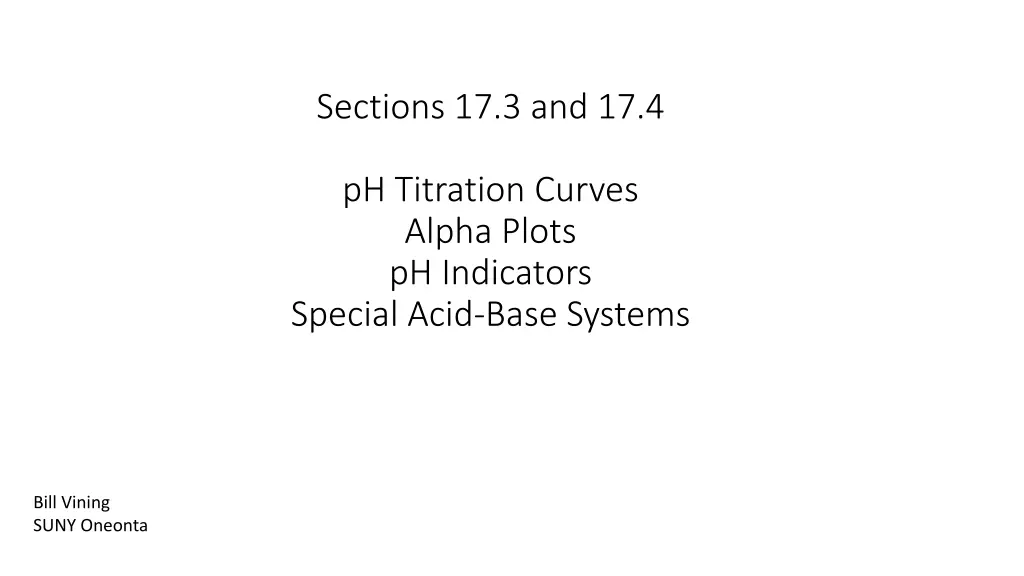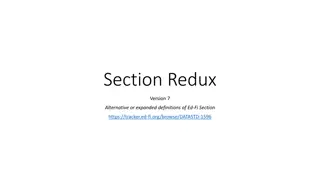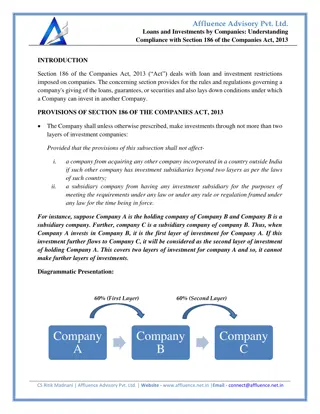
pH Titration Curves and Acid-Base Systems Analysis
Explore pH titration curves, alpha plots, and the behavior of acid-base systems in various scenarios such as strong/weak acids and bases, polyprotic acids like the carbonate system. Understand pH control in acid-base states using Henderson-Hasselbalch equations and find the form of species at specific pH values.
Download Presentation

Please find below an Image/Link to download the presentation.
The content on the website is provided AS IS for your information and personal use only. It may not be sold, licensed, or shared on other websites without obtaining consent from the author. If you encounter any issues during the download, it is possible that the publisher has removed the file from their server.
You are allowed to download the files provided on this website for personal or commercial use, subject to the condition that they are used lawfully. All files are the property of their respective owners.
The content on the website is provided AS IS for your information and personal use only. It may not be sold, licensed, or shared on other websites without obtaining consent from the author.
E N D
Presentation Transcript
Sections 17.3 and 17.4 pH Titration Curves Alpha Plots pH Indicators Special Acid-Base Systems Bill Vining SUNY Oneonta
pH Titrations Strong Acid Strong Base
pH Titrations Strong Base Strong Acid
pH Titration Weak Acid Strong Base
pH Titration Weak Acid Strong Base: Finding Ka
Polyprotic Acids: the carbonate system Ka1 = 4.2 x 10-7 Ka2 = 4.8 x 10-11 H2CO3 HCO3- CO32- What is the pH of a 0.10 M solution of H2CO3? What is [CO32-] in this solution?
Polyprotic Acids: the carbonate system Ka1 = 4.2 x 10-7 Ka2 = 4.8 x 10-11 H2CO3 HCO3- CO32- What is the pH of a 0.10 M solution of H2CO3? What is [CO32-] in this solution?
Polyprotic pH Titration Curves 14 12 10 8 pH 6 4 2 0 0 5 10 15 20 25 30 35 40 45 mL of base
When pH Controls Acid-Base State Situations where an acid-base species is a minor component in a solution where other things control the pH. Henderson-Hasselbalch and Alpha plots. HF + H2O H3O+ + F-. [base] pH = pK + log[acid] a Ka = 7.4 x 10-4 pKa = 3.13 pH [base]/[acid] 1.13 2.13 3.13 4.13 5.13
When pH Controls Acid-Base State [base] pH = pK + log[acid] a HF + H2O H3O+ + F-. Ka = 7.4 x 10-4 pKa = 3.13 At pH 4.9, in what form is the HF/F- system found?
Alpha Plot for an acid-base system with pKa = 9 [base] pH = pK + log[acid] a
Alpha Plot for the carbonate system H2CO3 HCO3- CO32- [base] Ka1 = 4.2 x 10-7 pH = pK + log[acid] a Ka2 = 4.8 x 10-11
Alpha Plot for the carbonate system H2CO3 HCO3- CO32- [base] Ka1 = 4.2 x 10-7 pH = pK + log[acid] a Ka2 = 4.8 x 10-11 For the carbonate system, at what pH is hydrogen carbonate, HCO3-, expected to predominate?
pH Indicators pH indicators are weak acid-base pairs for which the acid and base differ in color. The pH they change color at is the pKa of the weak acid.
pH Indicators The color change should occur at the steep inflection of the titration end-point. Titration of HClO
When pH Controls Acid-Base State: Amino Acids Situations where an acid-base species is a minor component in a solution where other things control the pH. pH = 0.00 pH = 2.34
pH = 0.00 pH = 2.34 pH = 7.00 pH = 9.60 pH = 13.00






















